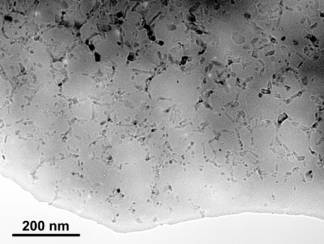

The basaltic Zagami meteorite belongs to the group of SNC meteorites that are currently believed to be
of Martian origin. In general, meteorites are ejected from their parent
body by an impact sufficiently strong to accelerate them, at least, to
the escape velocity of the parent body. As a consequence of the high escape
velocity of planet Mars (5.1 km/s) the SNC meteorites all display strong
signs of dynamic deformation at high pressure (i.e. shock metamorphism).
One sign of shock metamorphism is the formation of thin ( 100 µm),
shear-induced melt veins, so-called shock veins. We recently discovered
a number of tiny (<100 nm) high-pressure minerals in these veins using
analytical transmission electron microscopy (ATEM): omphacitic pyroxenes,
stishovite, silicate hollandites (K- and Na,Ca-rich), akimotoite (silicate
ilmenite), silicate titanite, and amorphous grains of silicate perovskite
composition. For the first time to our knowledge, we have reported the
natural occurrence of a ferromagnesian silicate titanite. Almost all of
these high-pressure phases have been formed by crystallization from the
melt at high pressure. However, to understand the formation of these phases
in more detail a basic knowledge of the composition, mineralogy, and microtexture
of the veins is required, leading to a general concept of the PTt
evolution of the veins.
100 µm),
shear-induced melt veins, so-called shock veins. We recently discovered
a number of tiny (<100 nm) high-pressure minerals in these veins using
analytical transmission electron microscopy (ATEM): omphacitic pyroxenes,
stishovite, silicate hollandites (K- and Na,Ca-rich), akimotoite (silicate
ilmenite), silicate titanite, and amorphous grains of silicate perovskite
composition. For the first time to our knowledge, we have reported the
natural occurrence of a ferromagnesian silicate titanite. Almost all of
these high-pressure phases have been formed by crystallization from the
melt at high pressure. However, to understand the formation of these phases
in more detail a basic knowledge of the composition, mineralogy, and microtexture
of the veins is required, leading to a general concept of the PTt
evolution of the veins.
EDX microanalyses and X-ray maps show large compositional variations and heterogeneity within the veins, reflecting the local composition of adjacent minerals and even their exsolution phenomena. For example, omphacitic pyroxenes and silicate hollandites have only been found in regions of veins where plagioclase contributed to the composition of the veins. Vein regions as thin as 1 µm with adjacent augite show a heterogeneous distribution of Ca, Fe, and Mg in the form of a Schlieren texture, being a relict of pigeonite exsolution lamellae in melted augite (Fig. 3.3-22).
 |
Mineralogy and microtexture provide clues to the formation mechanisms of the high-pressure phases and the (P,T) conditions of their crystallization. The highest pressures of ca. 30 GPa are recorded in the thinnest vein with amorphous perovskite as a major constituent. The boundaries of the ghost grains of perovskite are decorated with tiny (10 nm) stishovite and wüstite crystals, forming a loose network around the "perovskite" grains (Fig. 3.3-23). The overall appearance of this assemblage resembles an equilibrium texture with stishovite and wüstite being the subsequent decomposition products of perovskite. This decomposition probably happened in the solid-state upon decompression. Variable formation conditions are also recorded in vein regions as thick as 100 µm. In the central parts of the vein, polycrystalline silicate hollandites occur that may have crystallized from melt at pressures just below 23 GPa (Fig. 3.3-24). Zoned pyroxenes with vacancy-bearing omphacite cores dominate in the margins, suggesting formation at a pressure of ca. 5-10 GPa.
 |
 |
The variation in the pressure of formation does not reflect pressure heterogeneities within the veins but rather is a consequence of the variable cooling rates that result in quenching and solidification of veins at different stages of decompression. Our calculations suggest that cooling rates depend primarily on the vein thickness. For example, assuming an initial temperature difference between the vein and host rock of 2500 K it takes 0.6 ms to solidify a 100 µm thick vein, but only 60 ns for a 1 µm vein. These estimates of crystallization times are compatible with the conclusion that the high-pressure minerals observed in the vein crystallized in extremely short times, much shorter than the duration of the shock.
In addition to the understanding of the formation of the high-pressure phases in the impact event, our investigation may also provide important clues to the mineralogy of planetary interiors. The coexistance of ferromagnesian silicate titanite with akimotoite and "perovskite" suggests a formation at similarly high pressures and very high temperatures close to the liquidus. The crystal structure of titanite with mixed coordination of Si is intermediate between upper and lower mantle structures with purely tetrahedral or octahedral coordination of Si. The structure is also known to be a carrier of radioactive elements. Thus, silicate titanite could be an important constituent in the Earth's transition zone, containing a large portion of the radioactive inventory at this depth.

Tel: +49-(0) 921 55 3700 / 3766, Fax: +49-(0) 921 55 3769, E-mail: bayerisches.geoinstitut(at)uni-bayreuth.de
 Previous page
Previous page